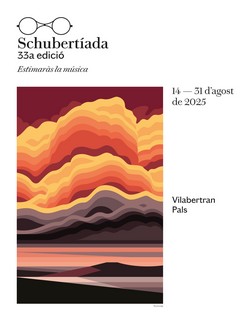
The Crucifixion (detail) - Roger van der Weiden
Franz Schubert was brought up in a catholic family, we know that for sure. Bearing that in mind, there are several theories about his religious feelings; Talking about people’s religious beliefs specially if they aren’t open about them, is always difficult. Apparently he moved away from his family’s beliefs, but he always kept some ties with them; in fact, many of his songs show some sort of religious feelings, often pantheistics: God’s identification with Nature was one of the main ideas during the literary Romanticism and often, Schubert took it in.
Some Schubert’s songs clearly have some Catholic context: Ellens Gesang III, Vom mitleiden Mariä, Die junge Nonne. Some scholars think that these Lieder meet the composer's beliefs; others consider that when the text refers to the Virgin Mary, like the two first mentioned songs, Schubert is evoking his mother, who died when he was fifteen years old and was boarding in the Konvikt. I might also be possible that the situations described in those poems prompted him to write the songs; the image of a mother who is looking at her son’s torture to death has often inspired many composers, from many Stabat Mater to songs like The Crucifixion, by Samuel Barber, or Vom mitleiden Mariä, our song this week.
Franz Schubert wrote sixteen Lieder from poems by Friedrich Schlegel between late 1818 and 1825. These aren't, in general, among his most popular ones; Aside from the one we're listening today, there are two that I particularly like, Der Wanderer, D649 and Im Walde, D708 (I specify the catalogue number because there are two other lieder with the same name). Actually, Im Walde is more than a song that I particularly like, it's a piece of art, but I'll talk about it another day.
The first seven Lieder out of the sixteen I mentioned were written between December 1818 and February 1819. At a time Schubert was focused on other genres after writing about three hundred songs. Vom mitleiden Mariä is the second song of this group. It seems that Schlegel's poem is a version of a 17th-century Jesuit anthem, maybe for this reason Schubert turned aside from his usual style to write a song in "stilo antico", a three-part poliphony, which remind us of Bach more than of Romantic music; There's no doubt that the composer took advantage of the lessons from his teacher Antonio Salieri. The appalling text that describes the son’s physical pain when nailed to the cross and the mother’s suffering at his feet shows in an austere song.
When I choose a song for my post, I usually have in mind a particular version, although I also listen to a few more just before deciding; All the more reason to do this week, because I was thinking of Ian Bostridge, to whom we listened last week. But the recording of Dietrich Fischer-Dieskau includes only two of the three stanzas, I find extremely slow the one of Gundula Janowitz (a singer I like very much) and any other catched my attention (in fact, there are just a few recordings of this song) so I went back to Ian Bostridge, who performs Vom mitleiden Mariä accompanied by Leiv Ove Andsnes.
Enjoy your Easter week!
Some Schubert’s songs clearly have some Catholic context: Ellens Gesang III, Vom mitleiden Mariä, Die junge Nonne. Some scholars think that these Lieder meet the composer's beliefs; others consider that when the text refers to the Virgin Mary, like the two first mentioned songs, Schubert is evoking his mother, who died when he was fifteen years old and was boarding in the Konvikt. I might also be possible that the situations described in those poems prompted him to write the songs; the image of a mother who is looking at her son’s torture to death has often inspired many composers, from many Stabat Mater to songs like The Crucifixion, by Samuel Barber, or Vom mitleiden Mariä, our song this week.
Franz Schubert wrote sixteen Lieder from poems by Friedrich Schlegel between late 1818 and 1825. These aren't, in general, among his most popular ones; Aside from the one we're listening today, there are two that I particularly like, Der Wanderer, D649 and Im Walde, D708 (I specify the catalogue number because there are two other lieder with the same name). Actually, Im Walde is more than a song that I particularly like, it's a piece of art, but I'll talk about it another day.
The first seven Lieder out of the sixteen I mentioned were written between December 1818 and February 1819. At a time Schubert was focused on other genres after writing about three hundred songs. Vom mitleiden Mariä is the second song of this group. It seems that Schlegel's poem is a version of a 17th-century Jesuit anthem, maybe for this reason Schubert turned aside from his usual style to write a song in "stilo antico", a three-part poliphony, which remind us of Bach more than of Romantic music; There's no doubt that the composer took advantage of the lessons from his teacher Antonio Salieri. The appalling text that describes the son’s physical pain when nailed to the cross and the mother’s suffering at his feet shows in an austere song.
When I choose a song for my post, I usually have in mind a particular version, although I also listen to a few more just before deciding; All the more reason to do this week, because I was thinking of Ian Bostridge, to whom we listened last week. But the recording of Dietrich Fischer-Dieskau includes only two of the three stanzas, I find extremely slow the one of Gundula Janowitz (a singer I like very much) and any other catched my attention (in fact, there are just a few recordings of this song) so I went back to Ian Bostridge, who performs Vom mitleiden Mariä accompanied by Leiv Ove Andsnes.
Enjoy your Easter week!
Vom mitleiden Mariä
Als bei dem Kreuz Maria stand,
Weh über Weh ihr Herz empfand
Und Schmerzen über Schmerzen;
Das ganze Leiden Christi stand
Gedruckt in ihrem Herzen.
Sie ihren Sohn muss bleich und tot,
Und überall von Wunden rot,
Am Kreuze leiden sehen.
Gedenk, wie dieser bitt’re Tod
Zu Herzen ihr musst’ gehen.
In Christi Haupt durch Bein und Hirn,
Durch Augen, Ohren, durch die Stirn’,
Viel scharfe Dornen stachen,
Dem Sohn die Dornen Haupt und Hirn,
Das Herz der Mutter brachen.
Please visit this link if you need an English translation.














Comments powered by CComment